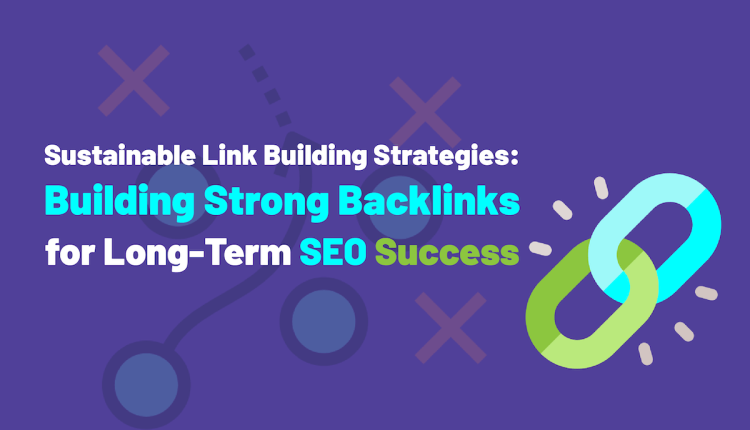Sustainable Link Building Strategies: Building Strong Backlinks for Long-Term SEO Success
Mastering Sustainable Link Building: Proven Strategies for Lasting SEO Impact
In the fast-evolving landscape of search engine optimization (SEO), link building remains a cornerstone for achieving long-term success. It’s not just about accumulating backlinks; it’s about building a sustainable strategy that fortifies your website’s authority, trustworthiness, and visibility on search engine results pages (SERPs). This comprehensive guide of Twilinstok will delve deep into the world of Sustainable Link Building Strategies, equipping you with the knowledge and techniques to create a strong foundation for your SEO endeavors.
The Importance of Sustainable Link Building
Link building is a practice that involves acquiring hyperlinks from other websites to your own. While it has been a core element of SEO for years, the landscape has evolved significantly. Why is link building so crucial? Simply put, it’s because search engines like Google perceive links as votes of confidence. When authoritative and relevant websites link to yours, search engines interpret this as an endorsement of your content’s quality and relevance. As a result, your website’s authority and rankings can improve.
However, not all links are created equal. In the early days of SEO, quantity often trumped quality, leading to the proliferation of spammy, low-value links. To combat this, search engines continuously refine their algorithms to prioritize quality over quantity. As a result, a sustainable approach to link building has become essential.
The risks associated with unethical link building practices, often referred to as “black-hat SEO,” can’t be understated. Engaging in practices like buying links or participating in link schemes can lead to severe penalties, including the loss of search rankings or even deindexing from search engine results entirely. In contrast, ethical or “white-hat” SEO practices, which focus on quality and relevance, are not only safer but also more effective in the long run.
In this guide, we’ll explore sustainable link building strategies designed to withstand the test of time and the evolving search algorithms. Whether you’re a seasoned SEO professional or just starting your journey, these strategies will help you build strong backlinks that contribute to your website’s long-term success.

The Foundation of Sustainable Link Building
Understanding Backlinks
To embark on a journey of sustainable link building, you must first grasp the concept of backlinks. At its core, a backlink is a hyperlink from one web page to another. These links serve as pathways that connect different parts of the internet. When a website links to your content, it’s essentially vouching for your credibility and authority in your niche or industry. Understanding the significance of these virtual votes of confidence is the first step towards effective link building.
Quality Over Quantity
In the early days of SEO, the race to accumulate as many backlinks as possible often led to quantity taking precedence over quality. This approach is no longer viable and can even harm your SEO efforts. Quality, as measured by factors like the authority and relevance of the linking site, now reigns supreme. Search engines are becoming increasingly sophisticated at identifying and rewarding high-quality backlinks while penalizing low-quality or spammy links. Therefore, your focus should shift towards acquiring links from authoritative sources within your niche or industry.
White-Hat vs. Black-Hat SEO
Ethics play a significant role in sustainable link building. Engaging in black-hat SEO practices like buying links or participating in link schemes can yield short-term gains but expose your website to significant risks. On the other hand, white-hat SEO tactics emphasize ethical and sustainable practices that prioritize long-term growth and safety. In this guide, we’ll explore strategies that align with white-hat principles, ensuring that your link building efforts contribute positively to your website’s health and longevity.
Proven Sustainable Link Building Strategies
Here are 4 proven sustainable link building strategies:
- Guest posting for authority
- Content marketing and link baiting
- Outreach and relationship building
- Resource link building
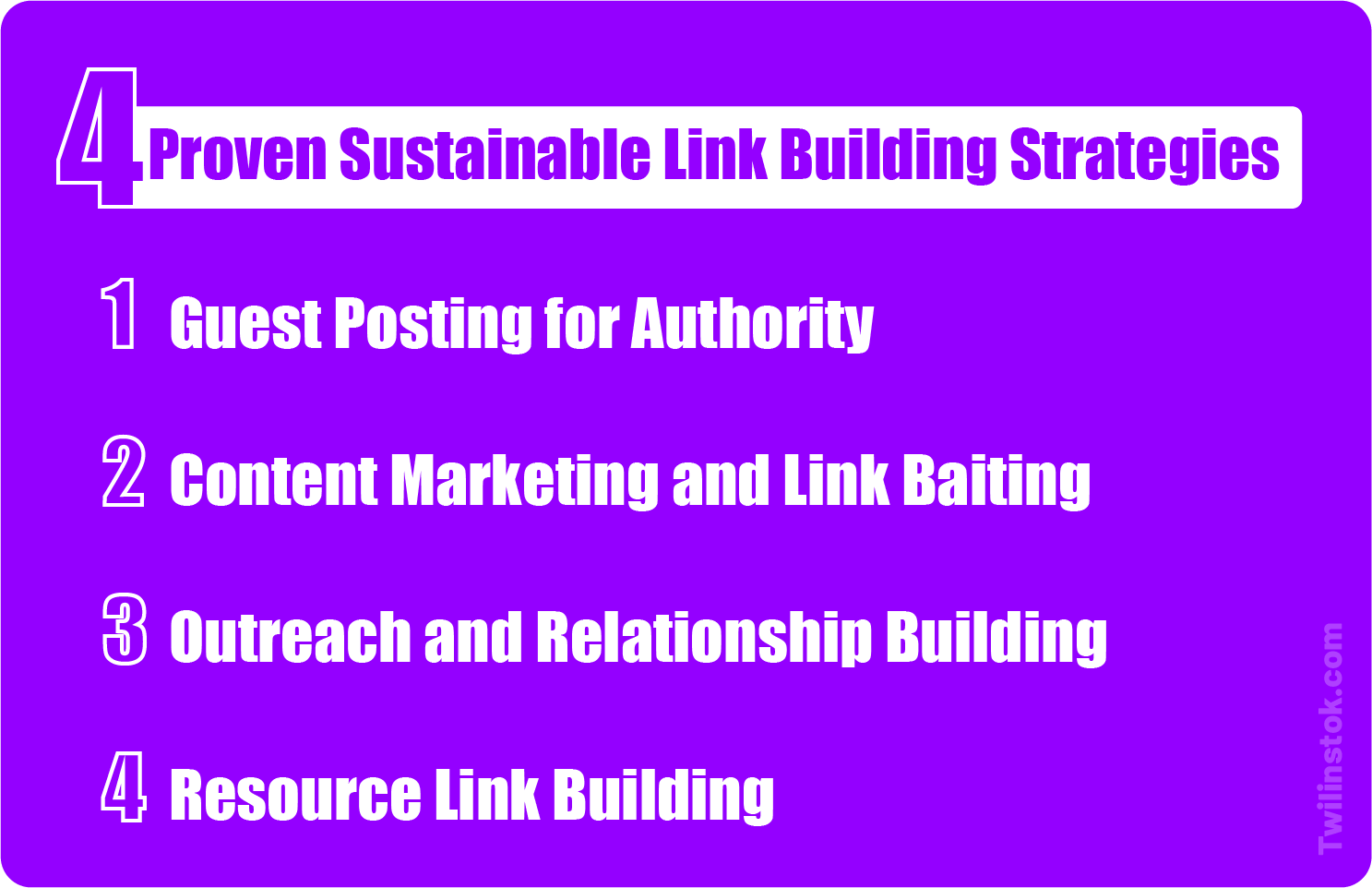
Now let’s check these strategies.
Guest posting, or contributing articles to other websites within your niche, is a time-tested method for building high-quality backlinks. By creating valuable content for authoritative websites, you not only earn a backlink but also establish yourself as an authority in your field.
In other words, guest posting is a highly effective strategy for acquiring quality backlinks and establishing your authority within your niche. The concept is simple: you write a guest article for another website or blog in exchange for a backlink to your site. To succeed with guest posting:
Content Marketing and Link Baiting
Creating exceptional content is the linchpin of sustainable link building. When your content provides value, it naturally attracts backlinks.
In other words, creating valuable and shareable content is at the core of content marketing and link baiting. The idea is to craft content that naturally attracts backlinks from authoritative sources because it’s informative, unique, or highly engaging.
Outreach and Relationship Building
Building relationships within your industry or niche can be a game-changer for link building. Outreach involves reaching out to other website owners, influencers, or bloggers to establish connections and encourage them to link to your content. Effective outreach can result in organic backlinks and collaborations that benefit all parties involved.
Resource Link Building
Resource link building involves creating valuable resources, such as guides, tools, or industry reports, that naturally attract backlinks because they’re genuinely useful. These resources serve as references within your niche, making them prime targets for other websites looking to cite authoritative content.
These are just a few examples of sustainable link building strategies. The key is to focus on providing value to your target audience and the websites you collaborate with. By doing so, you’ll naturally earn high-quality backlinks that boost your site’s authority and long-term SEO success.
In the following sections of this guide, we’ll delve deeper into each of these sustainable link building strategies, providing practical tips, tools, and real-world examples to illustrate their effectiveness. By the time you finish reading, you’ll be equipped with the knowledge and strategies needed to embark on a successful and sustainable link building journey.
Best Practices for Link Optimization
Here are 6 best practices for link optimization:
- Anchor text optimization
- Internal linking strategy
- Mobile-friendly links
- Link reclamation
- Schema markup for rich snippets
- Monitor and analyze link performance
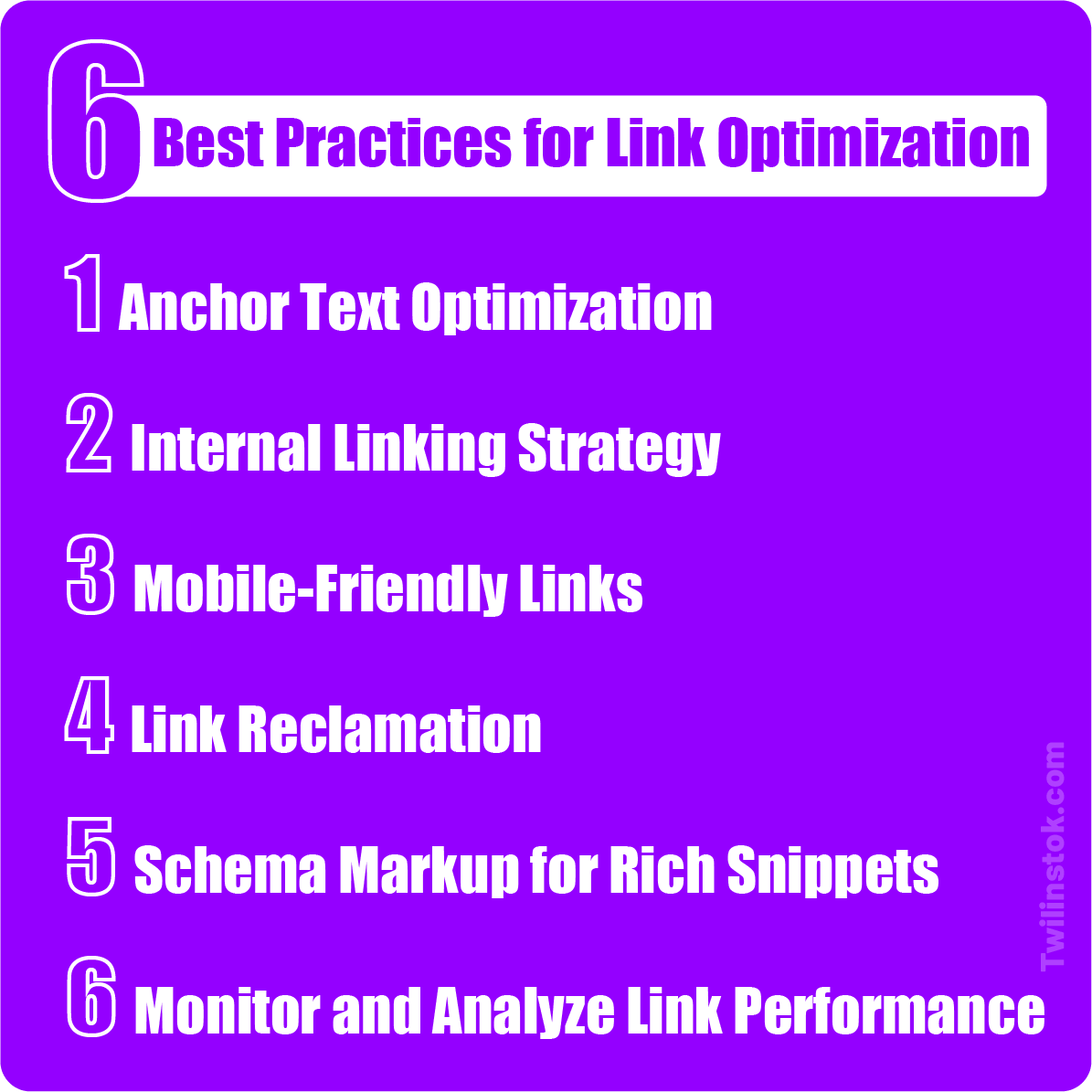
Now let’s check these practices.
Anchor Text Optimization
Anchor text optimization involves using descriptive and relevant anchor text for your backlinks. This helps search engines understand the context and relevance of the linked content.
Internal Linking Strategy
Internal linking involves linking to other relevant pages within your own website. It helps distribute link authority across your site and keeps visitors engaged.
Mobile-Friendly Links
In today’s mobile-centric world, ensuring that your links are mobile-friendly is crucial. This means that they are easily clickable and accessible on mobile devices.
Link Reclamation
Link reclamation is the process of identifying and fixing broken or outdated backlinks pointing to your website.
Schema Markup for Rich Snippets
Implementing schema markup on your website can result in rich snippets in search engine results, making your links more visually appealing and informative.
Monitor and Analyze Link Performance
Regularly monitoring and analyzing the performance of your backlinks is essential for optimization. Tools like Google Analytics and Google Search Console can help you track traffic and engagement generated by your links.
These best practices for link optimization ensure that your backlinks not only boost your SEO but also enhance the user experience, leading to sustained, long-term success.
Measuring and Monitoring Link Building Success
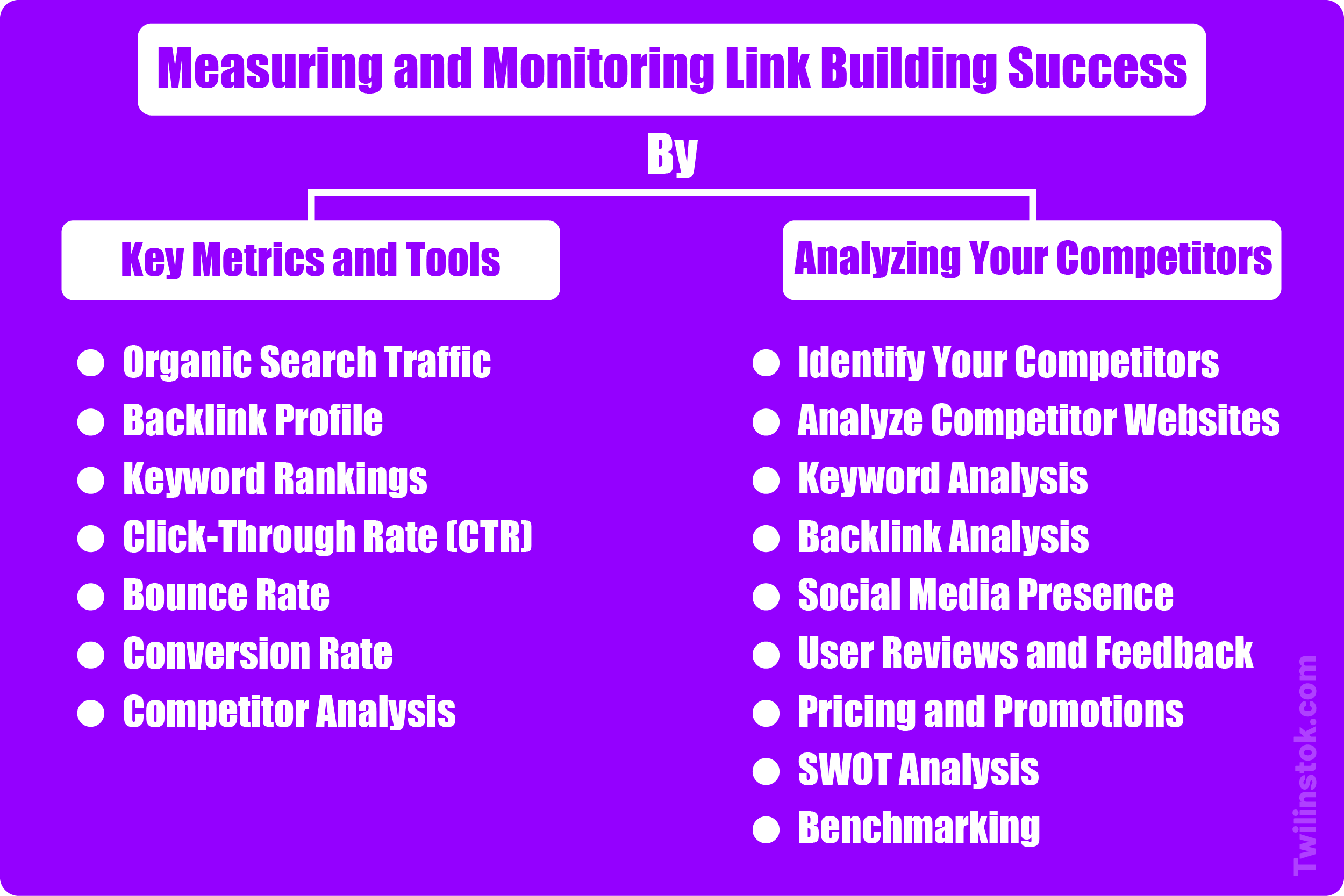
Key Metrics and Tools
One of the most important aspects of sustainable link building that many SEOs usually neglect is monitoring key metrics and tools. In this regard, you need to discover the necessary metrics and tools to measure the success of your link building efforts. These essential metrics and tools are:
- Organic search traffic
- Backlink profile
- Keyword rankings
- Click-through rate (CTR)
- Bounce rate
- Conversion rate
- Competitor analysis
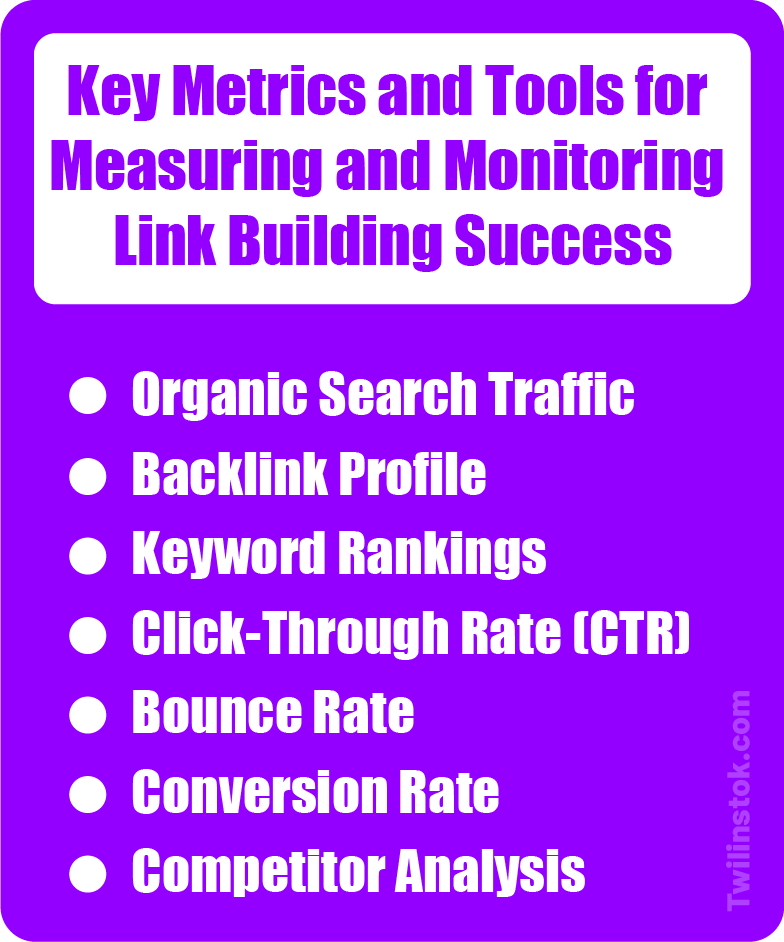
Now let’s check these key metrics and tools.
Organic Search Traffic
- Key Metric: Organic search traffic refers to the number of visitors who land on your website through unpaid, organic search engine results.
- Example: Suppose you run an e-commerce website selling fitness equipment. Using Google Analytics, you can track organic search traffic to see how many visitors arrive at your site after searching for terms like “home gym equipment” or “dumbbells for sale.” This metric helps you gauge the effectiveness of your SEO efforts in attracting potential customers.
- Tools: Google Analytics, Bing Webmaster Tools, SEMrush.
Backlink Profile
- Key Metric: Your backlink profile encompasses all the websites and pages that link to your site. It’s crucial to assess the quality and quantity of these backlinks.
- Example: Utilizing tools like Ahrefs or Moz’s Link Explorer, you can analyze your backlink profile. Look for high-authority domains that link to your content. For instance, if a well-known fitness magazine links to your e-commerce store in an article about home workouts, it’s a valuable backlink that boosts your SEO.
- Tools: Ahrefs, Moz, SEMrush.
Keyword Rankings
- Key Metric: Keyword rankings indicate how well your website or specific pages rank in search engine results for target keywords.
- Example: If your fitness equipment website aims to rank for “best home gym machines,” you can use tools like SEMrush or Google Search Console to monitor your keyword rankings. Tracking improvements or declines in rankings helps you adjust your content and SEO strategies accordingly.
- Tools: SEMrush, Google Search Console, Ahrefs.
Click-Through Rate (CTR)
- Key Metric: CTR represents the percentage of users who click on your link after seeing it in search results.
- Example: Google Search Console provides valuable data on CTR. If your e-commerce store’s product pages have a low CTR, it may indicate that your meta titles and descriptions need optimization. You can then experiment with more compelling titles to improve CTR and attract more visitors.
- Tools: Google Search Console, Google Analytics.
Bounce Rate
- Key Metric: Bounce rate reveals the percentage of users who leave your site after viewing only one page, indicating whether your content engages visitors.
- Example: Let’s say you have a blog post reviewing the top treadmills for home use. Google Analytics can show you the bounce rate for this page. If it’s high, it might suggest that your content isn’t retaining readers. You can then enhance the article with engaging visuals or more detailed information.
- Tools: Google Analytics, Clicky, Hotjar.
Conversion Rate
- Key Metric: Conversion rate measures the percentage of visitors who take a desired action on your site, such as making a purchase or signing up for a newsletter.
- Example: If you’re running an SEO campaign to increase e-commerce sales, tools like Google Analytics can help you track conversion rates for specific landing pages. You can see which pages convert well and which might need optimization to improve the conversion rate.
- Tools: Google Analytics, Kissmetrics, HubSpot.
Competitor Analysis
- Key Metric: Competitive analysis involves assessing the SEO strategies and performance of your competitors.
- Example: To gain insights, you can use tools like SEMrush to analyze the keywords your competitors are ranking for and the backlinks they’ve acquired. This information helps you identify gaps in your own strategy and uncover opportunities.
- Tools: SEMrush, Ahrefs, SpyFu.
By regularly monitoring these key metrics and employing the right tools, you can fine-tune your sustainable link building strategies and ensure long-term SEO success.
Analyzing Your Competitors
Competitor analysis is one of the most fundamental parts of a sustainable link building strategy. In this regard, you should learn how to analyze your competitors’ link profiles to find new opportunities. Next, we describe how to analyze competitors in the form of a small local coffee shop. Here are some tips:
- Identify your competitors
- Analyze competitor websites
- Keyword analysis
- Backlink analysis
- Social media presence
- User reviews and feedback
- Pricing and promotions
- SWOT analysis
- Benchmarking
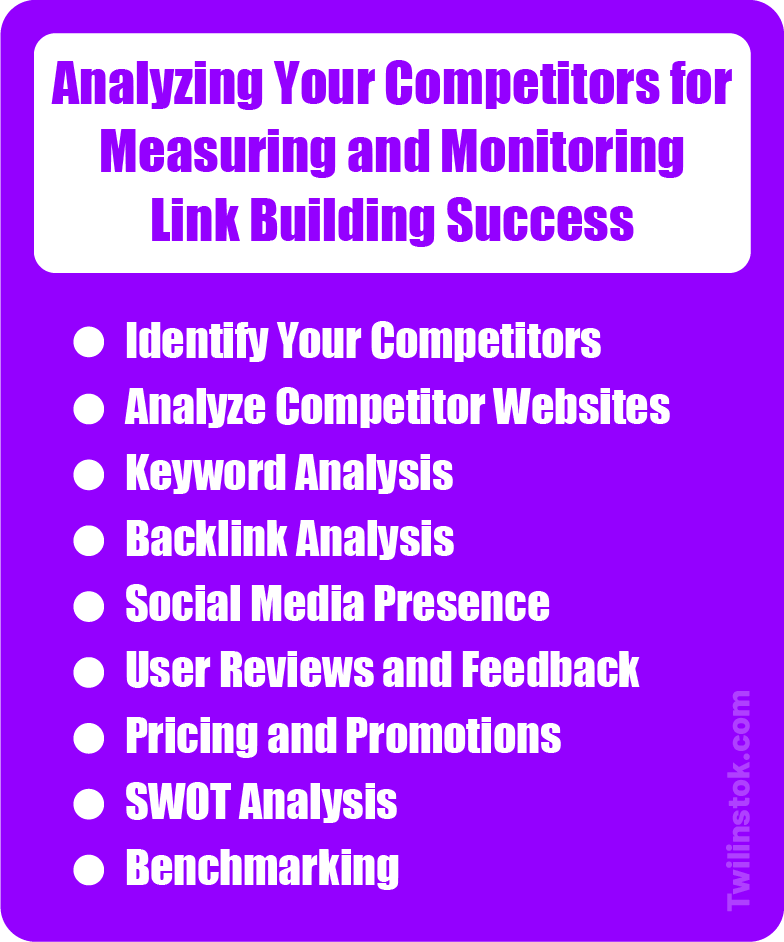
Now let’s check these tips.
Identify Your Competitors
- Method: Start by identifying your direct competitors in your niche or industry.
- Example: Suppose you run a small coffee shop. Your competitors would include other local coffee shops, as well as well-known chains like Starbucks and Dunkin’. Make a list of these competitors to proceed with the analysis.
Analyze Competitor Websites
- Method: Visit your competitors’ websites and thoroughly analyze their content, design, user experience, and SEO strategies.
- Example: If you’re competing with local coffee shops, visit their websites and note how they present their menu, coffee varieties, and any promotions. Pay attention to how they structure their content, use images, and encourage visitors to engage or make purchases.
- Tools: Manual observation, web browser.
Keyword Analysis
- Method: Perform keyword research to identify the keywords your competitors are targeting.
- Example: Using tools like SEMrush or Ahrefs, you can input your competitors’ websites and view the keywords they rank for. If a local coffee shop is successfully ranking for keywords like “best coffee in [your city],” consider optimizing your content for similar terms.
- Tools: SEMrush, Ahrefs, Moz.
Backlink Analysis
- Method: Analyze your competitors’ backlink profiles to discover valuable linking opportunities.
- Example: Tools like Ahrefs or Moz’s Link Explorer allow you to input your competitors’ URLs and see which websites are linking to them. For your coffee shop, if a local food blog is linking to a competitor, you could reach out to the blog for a potential collaboration or feature.
- Tools: Ahrefs, Moz, SEMrush.
- Method: Explore your competitors’ social media profiles to understand their social engagement and content strategies.
- Example: Check if local coffee shops post daily specials, engage with customers in the comments, or run contests. If you notice successful engagement strategies, consider implementing similar approaches on your coffee shop’s social media.
- Tools: Social media platforms (e.g., Facebook, Instagram, Twitter).
User Reviews and Feedback
- Method: Examine user reviews and feedback on platforms like Yelp, Google Reviews, or social media to gauge customer satisfaction.
- Example: If customers consistently praise a competitor for its friendly staff or unique coffee blends, take note of these strengths. You can then focus on enhancing similar aspects of your coffee shop to attract more positive reviews.
- Tools: Yelp, Google Reviews, social media platforms.
Pricing and Promotions
- Method: Investigate your competitors’ pricing strategies and promotions.
- Example: If a nearby coffee shop offers a loyalty program that rewards customers with free coffee after a certain number of visits, consider launching a similar program. Analyze how pricing compares to competitors and adjust accordingly to stay competitive.
SWOT Analysis
- Method: Perform a SWOT (Strengths, Weaknesses, Opportunities, Threats) analysis for each competitor.
- Example: Create a table for each competitor, listing their strengths (e.g., excellent location), weaknesses (e.g., limited menu), opportunities (e.g., local events to sponsor), and threats (e.g., new competitors). This comprehensive analysis will help you identify areas where your coffee shop can excel.
Benchmarking
- Method: Benchmark your coffee shop’s performance against your competitors.
- Example: If a nearby coffee shop has more social media followers, set a goal to increase your own following to match or surpass theirs. Regularly compare your performance metrics (e.g., sales, online reviews, website traffic) with those of your competitors.
By thoroughly analyzing your competitors using these methods and tools, you can gain valuable insights to refine your strategies, stay competitive, and ultimately achieve long-term success for your coffee shop or business.
Conclusion: Building a Strong Foundation for SEO Success
In conclusion, sustainable link building is not a one-time effort but a dynamic process that requires continuous adaptation and refinement. By implementing the proven sustainable link building strategies outlined in this guide, such as creating high-quality content, fostering genuine relationships, and analyzing competitors, you can build a robust backlink profile that will stand the test of time.
Remember, the key to long-term SEO success is to focus on quality over quantity, prioritize user value, and stay updated with industry trends. With dedication and a commitment to ethical link building practices, you can strengthen your online presence and enjoy lasting benefits in the ever-evolving digital landscape.
If you’re looking to secure your website’s future in search rankings, these sustainable link building strategies are your path to success.
For more information about Search Engine Optimization, we suggest that you click on Free SEO Tutorial [+]. Also, if you have any questions about SEO, you can ask them in our SEO support center [+] in the form of a topic and wait for the answer of our experts.
FAQs
What is sustainable link building?
Sustainable link building is a long-term approach to acquiring backlinks for a website through ethical and value-driven methods. It focuses on building high-quality, relevant, and lasting links that benefit both users and search engine rankings.
Why is sustainable link building important for SEO?
Sustainable link building is vital for SEO because it helps improve a website’s authority, credibility, and visibility in search engine results. High-quality backlinks from reputable sources can boost organic rankings and drive targeted traffic.
What are some sustainable link building strategies?
Sustainable link building strategies include creating valuable content, guest posting on relevant websites, building relationships with industry influencers, and earning links through natural mentions. These methods prioritize quality over quantity.
How can I measure the success of my link building efforts?
Success in link building can be measured through key metrics like domain authority, referral traffic, and keyword rankings. Tools such as Moz, Ahrefs, and Google Analytics can provide valuable insights into your link building performance.
Is sustainable link building a one-time effort?
No, sustainable link building is an ongoing process. It requires continuous monitoring, adaptation to algorithm changes, and the consistent creation of valuable content to attract and retain high-quality backlinks.

